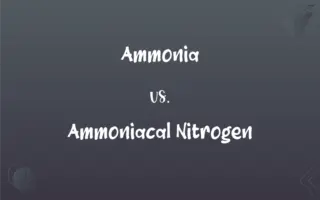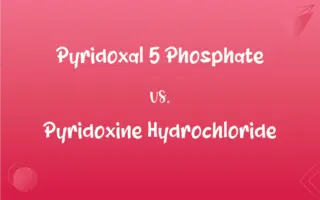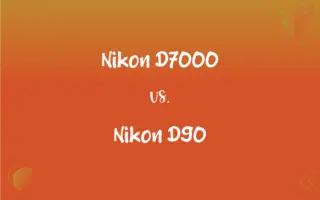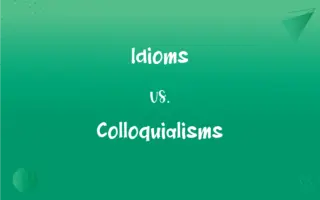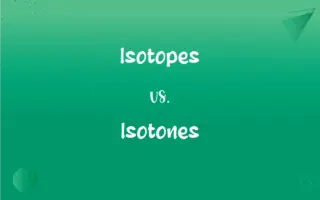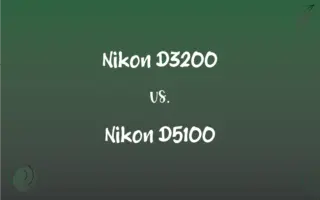Crystal Field Stabilization Energy vs. Crystal Field Splitting Energy: What's the Difference?
Edited by Aimie Carlson || By Janet White || Published on December 31, 2024
Crystal field stabilization energy (CFSE) is the energy benefit from electron arrangement in a d-orbital split, while crystal field splitting energy (CFSE) measures the energy difference between split d-orbitals.
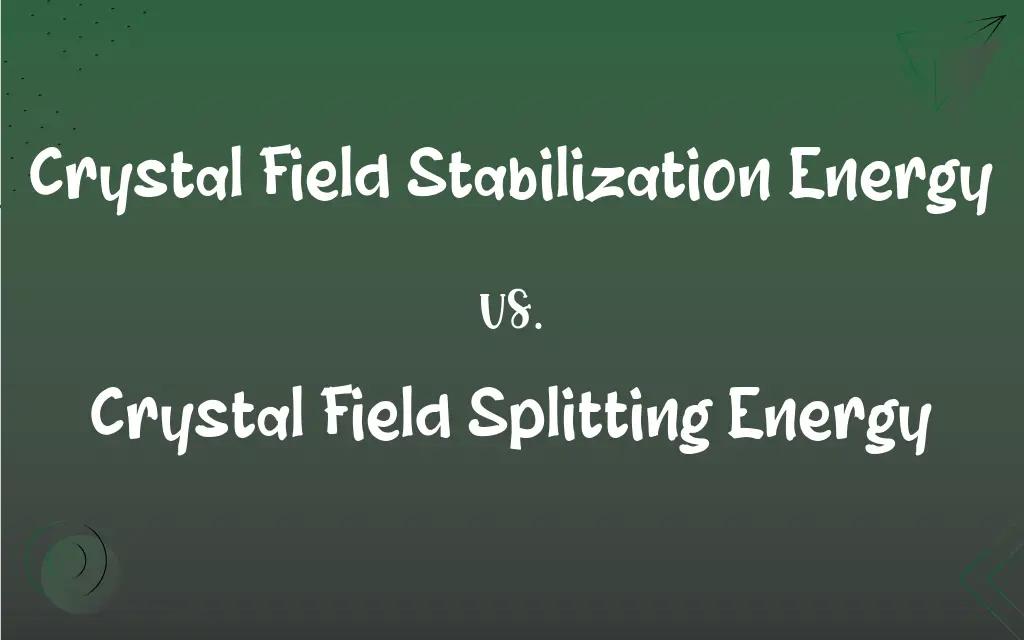
Key Differences
Crystal field stabilization energy (CFSE) quantifies the energy stabilization experienced by a metal ion in a crystal field due to the specific arrangement of its d-electrons among the split d-orbitals. Crystal field splitting energy (CFSE), on the other hand, refers to the energy difference created between the higher and lower sets of d-orbitals when a metal ion is surrounded by ligands, causing the d-orbitals to split into two or more energy levels.
The concept of CFSE is particularly relevant in understanding the stability and color properties of coordination compounds, as it helps explain why certain electron configurations are more stable than others within a crystal field. The CFSE is a value that can be positive or negative, depending on the electronic configuration of the metal ion and the geometry of the coordination complex. Crystal field splitting energy, however, is always a positive value, representing the energy required to overcome the repulsion between electrons when distributed among the newly formed d-orbital energy levels.
CFSE plays a crucial role in determining the magnetic properties and the overall stability of coordination complexes. It influences the spin state of the metal ion, which can be either high-spin or low-spin depending on the relative sizes of CFSE and pairing energy. Crystal field splitting energy is essential in predicting the distribution of electrons among the d-orbitals, which directly impacts the magnetic properties and the possibility of electron pairing.
In the context of spectroscopy and color of coordination compounds, CFSE contributes to the understanding of why certain compounds absorb specific wavelengths of light, leading to their characteristic colors. Crystal field splitting energy is directly related to the absorption of light; the energy difference between the split d-orbitals corresponds to the energy of the light absorbed, thus determining the color of the compound.
The calculation of CFSE requires knowledge of the electronic configuration of the metal ion, the geometry of the coordination complex, and the pairing energy of electrons. This calculation provides insight into the thermodynamic stability and reactivity of coordination complexes. Crystal field splitting energy is determined by factors such as the nature of the ligands surrounding the metal ion and the geometry of the coordination complex, influencing the extent to which the d-orbitals are split.
ADVERTISEMENT
Comparison Chart
Definition
Energy stabilization from electron arrangement in d-orbitals
Energy difference between higher and lower d-orbital levels
Significance
Influences stability and magnetic properties
Determines electron distribution and color of compounds
Value Nature
Can be positive or negative
Always positive
Dependence on Geometry
Influenced by coordination complex geometry
Directly related to complex geometry
Impact on Spectroscopic Properties
Affects color through electron transitions
Related to light absorption and compound color
ADVERTISEMENT
Crystal Field Stabilization Energy and Crystal Field Splitting Energy Definitions
Crystal Field Stabilization Energy
Influences the reactivity and formation of coordination compounds.
Complexes with high CFSE are less likely to undergo ligand substitution.
Crystal Field Splitting Energy
Determines the color of coordination compounds.
The CFSE value is directly related to the wavelength of light absorbed by a complex.
Crystal Field Stabilization Energy
Reflects the stability of coordination compounds.
A high CFSE value indicates a more stable complex.
Crystal Field Splitting Energy
Energy difference due to d-orbital splitting in a ligand field.
In a crystal field, the CFSE for octahedral complexes is determined by the ligand's nature.
Crystal Field Stabilization Energy
Energy stabilization due to electron configuration in a crystal field.
In octahedral complexes, CFSE contributes to the color and magnetic properties.
Crystal Field Splitting Energy
Influences the high-spin or low-spin state of electrons.
A large CFSE can cause a transition from a high-spin to a low-spin state.
Crystal Field Stabilization Energy
Involves electron distribution in d-orbitals.
CFSE calculations help predict the spin state of complexes.
Crystal Field Splitting Energy
Depends on ligand strength and geometry.
Strong field ligands increase the CFSE, leading to greater splitting.
Crystal Field Stabilization Energy
Affects magnetic and optical properties of complexes.
CFSE is crucial for understanding the low-spin configurations in coordination chemistry.
Crystal Field Splitting Energy
Affects the stability and formation of complexes.
Complexes with smaller CFSE values are more susceptible to ligand field changes.
FAQs
How does CFSE affect a coordination complex's stability?
Higher CFSE indicates greater stability of the coordination complex due to lower energy electron configurations.
Can CFSE be negative?
Yes, CFSE can be negative if the electrons are placed in higher energy orbitals, leading to destabilization.
Is CFSE important for all metal complexes?
CFSE is particularly relevant for transition metal complexes where d-orbital splitting occurs.
What is crystal field stabilization energy (CFSE)?
CFSE is the energy gain when d-electrons are placed in a lower energy state due to the crystal field effect.
How do ligands affect crystal field splitting energy?
Strong field ligands increase CFSE, causing greater splitting and potentially changing the spin state.
What does crystal field splitting energy (CFSE) measure?
CFSE measures the energy difference between the split d-orbital levels in a crystal field.
How is CFSE related to the color of a complex?
CFSE affects the energy levels involved in electronic transitions, influencing the color of the complex.
What role does CFSE play in determining magnetic properties?
CFSE influences whether a complex adopts a high-spin or low-spin configuration, affecting its magnetic properties.
What factors influence crystal field splitting energy?
The nature of the ligands and the geometry of the coordination complex primarily influence CFSE.
Does crystal field splitting energy change with coordination geometry?
Yes, CFSE varies significantly with the geometry of the complex, such as octahedral or tetrahedral.
Can CFSE predict reactivity of coordination compounds?
Yes, complexes with high CFSE tend to be less reactive, as they are more energetically stable.
Does CFSE vary among different metal ions?
Yes, CFSE varies depending on the metal ion's electronic configuration and its interaction with the ligands.
How does the concept of CFSE assist in the design of coordination compounds?
Understanding CFSE helps chemists design coordination compounds with desired properties, such as specific magnetic behaviors or colors, by selecting appropriate ligands and metal ions.
What is the relationship between CFSE and ligand field theory?
CFSE is a key concept in ligand field theory, explaining the energy differences in metal-ligand bonding.
How do high-spin and low-spin configurations relate to CFSE?
The size of CFSE can determine whether a complex adopts a high-spin or low-spin electron configuration.
How is CFSE related to thermodynamic stability?
A positive CFSE contributes to the thermodynamic stability of a complex by lowering its overall energy.
How can CFSE be calculated?
CFSE calculations consider the electron configuration, ligand field strength, and complex geometry.
How does CFSE influence spectroscopic properties?
CFSE determines the energy levels for electronic transitions, affecting spectroscopic properties.
Can CFSE impact the choice of ligands in complex formation?
Yes, ligands that result in higher CFSE are often preferred for synthesizing more stable complexes.
Can CFSE be used to predict the formation constants of complexes?
Yes, complexes with higher CFSE values generally have larger formation constants, indicating stronger bonding and higher stability.
About Author
Written by
Janet WhiteJanet White has been an esteemed writer and blogger for Difference Wiki. Holding a Master's degree in Science and Medical Journalism from the prestigious Boston University, she has consistently demonstrated her expertise and passion for her field. When she's not immersed in her work, Janet relishes her time exercising, delving into a good book, and cherishing moments with friends and family.
Edited by
Aimie CarlsonAimie Carlson, holding a master's degree in English literature, is a fervent English language enthusiast. She lends her writing talents to Difference Wiki, a prominent website that specializes in comparisons, offering readers insightful analyses that both captivate and inform.






















